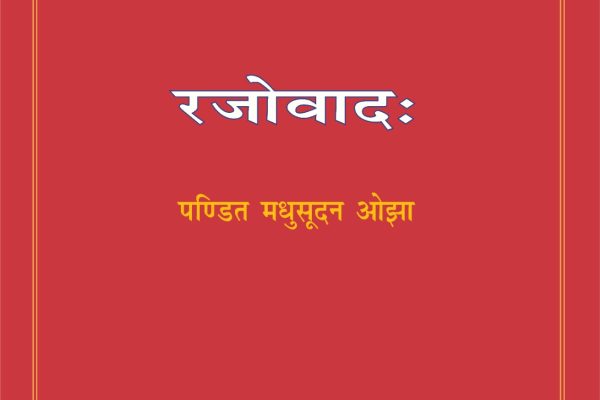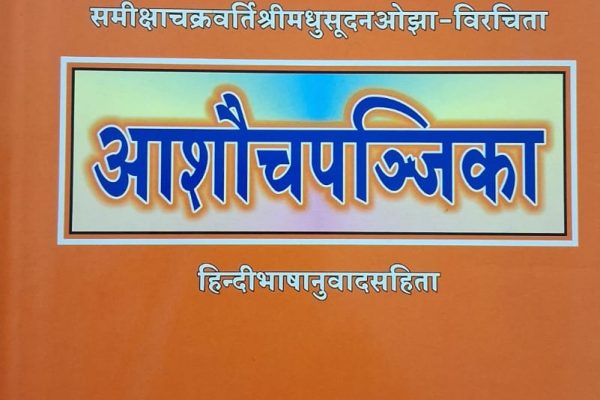Report Shri Shankar Shikshayatan on March 30, 2024 organised a National Seminar on Pandit Madhusudan Ojha’s Indravijayaha. The discussion focused on the first chapter of the book, Seemaprasanga or the chapter on territorial limits. The chapter explains the east and western territorial limits of Bharatavarsha on the basis of 14 evidence drawn from shastras. The meeting was chaired by Prof. Santosh Kumar Shukla of Jawaharlal Nehru University, New Delhi. The meeting was addressed by Prof. Mahanand Jha of Shri Lal Bahadur Shastri Rashtriya Sanskrit Vidyapeeth, Prof. Vaidyanath Mishra, Jaiprakash University, Chapra, Bihar and Dr Suryakant Tripathi of Deendayal Upadhyaya Gorakhpur University, Gorakhpur. The chief guest at the meeting was the Chancellor of Netaji Subash University, Jamshedpur, Prof. Gangadhar Panda. He presented the summary of 14 proofs for the geographical expanse of Bharatavarsha contained in the shastras. He said Ojhaji had established the eastern and western boundaries on the basis of these evidence. The reference point for this division was Indus river. Ojahji has stated that the eastern boundary stretched from the China Sea to the Red Sea in the west. “चीनसमुद्रारब्धं रक्तसमुद्रन्तमिष्यते यदिदम्।भारतवर्षं तत्र च हेतव एते प्रदर्श्यन्ते ॥”, इन्द्रविजय, पृ.२२ cheenasamudrarabhdam raktasamundramishyate yadidambharatavarsha tatra cha hetava aite pradhasharyante.–Indravijayaha, p 22 Dr Suryakant Tripathi spoke on the sixth proof and said it showed Bharatavarsha in the ancient geography as part of the northern group of countries like Gandharmadra, Parad, Pahhava, Kamboja, Shak and Yavan. In Brahatsamhita, it is mentioned that from the centre to east of Bharatavarsha were countries like Haihaiya, Parad and Shak. In the west were countries like Thukhar and Madra. “पौराणिके भुवनकोशे भरतवर्षीयावान्तरदेश-परिगणनासूदीच्यदेशतया गान्धार-मद्र-पारद-पह्लव-कम्बोज-शक-यवनादिदेशानामुल्लेखादेषां देशानां पुरायुगेभारतीयत्वमासीदित्युपगम्यते। बृहत्संहितायां च ‘भारतवर्षे मध्यात्प्रागादिविभाजिता देशाः। इति प्रतिज्ञाय’ पश्चिमायां हैहय-पारद-शकदेशानांपश्चिमोत्तरस्यां च तुखारमद्रादिदेशानामाख्यानात् तत्कालेप्येषां भारतवर्षीयत्वंसुप्रसिद्धमिति गम्यते।”, वही, पृ.१०० pauranike bhuvankoshe Bharatvarshiyavantardesha parigananasudichyadeshataya Gandhar-Madraparad,Pahhava, Kamboja, Shak, Yavanadideshanamullekhadesham deshanam purayugeBharatiyatvamasidityupagamyate, brihatsamhitayam cha Bharatavarshe madhyatpragadivibhajita deshaha, iti pratigyay paschimayam haihaiya-parad-shakadeshanampaschimottarasyam cha thukharmadradideshanamakhyanat tatkalepyesham Bharatvarshiyatvamsuprasidhamiti gamyate–Indravijayaha, p 100 Prof. Vaidyanath Mishra spoke on the tenth proof and said references to this proof could be found in Srauthagrantha, Brahmana and Matsyapurana. These references prove the presence of a town in Samadesha . These references prove the existence of three purs. Tripur was first established by an asur named maya. Others created similar Tripur subsequently. यतोऽथवा सर्वत्र एवं पूर्वं मयासुरेण त्रिपुरं प्रणीतम्।ख्यातस्ततोऽभूत् त्रिपुरोऽसौ पश्चात्परे त्रीणि पुराणि चक्रुः॥” , वही, पृ. १२०yatothava sarvatra evam purva mayasurena tripuram pranithamkhyatastatobhut tripurosau paschatpare trini purani chakruha.–Indravijayah, p.120 Prof. Mahanand Jha spoke on the river Indus and the reason for Bharatavarsha being called Sindhustan. He also spoke on the term, Aryavarta. He said Ojhaji had taken references from Srimadbhagvatapuranam to establish the 14 proofs for thesis. Prof. Santosh Kumar Shukla said of the many disputable verses, one is seema-vivad or territorial dispute. When two countries have disputes over territory and boundary, the solution to such disputes are found in seema-vivad. There have been lot of disputes over Bharatavarsha’s eastern and western boundaries and hence Ojhaji has presented a detailed explanation of the disputes and solutions with evidence from the puranas and other shastras. The programme, attended by several students, teachers and scholars from different universities, was conducted by Dr Mani Shankar Dwivedi and Dr Lakshmi Kant Vimal of Shri Shankar Shikshayatan.





